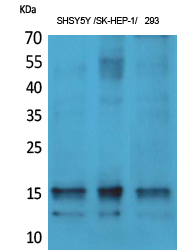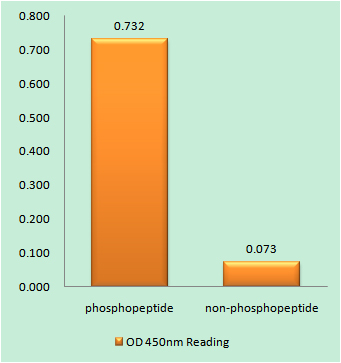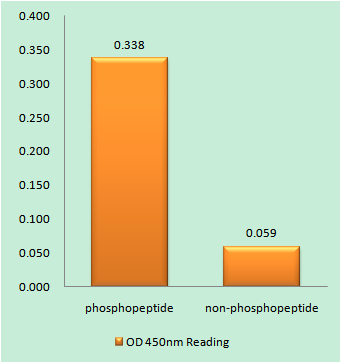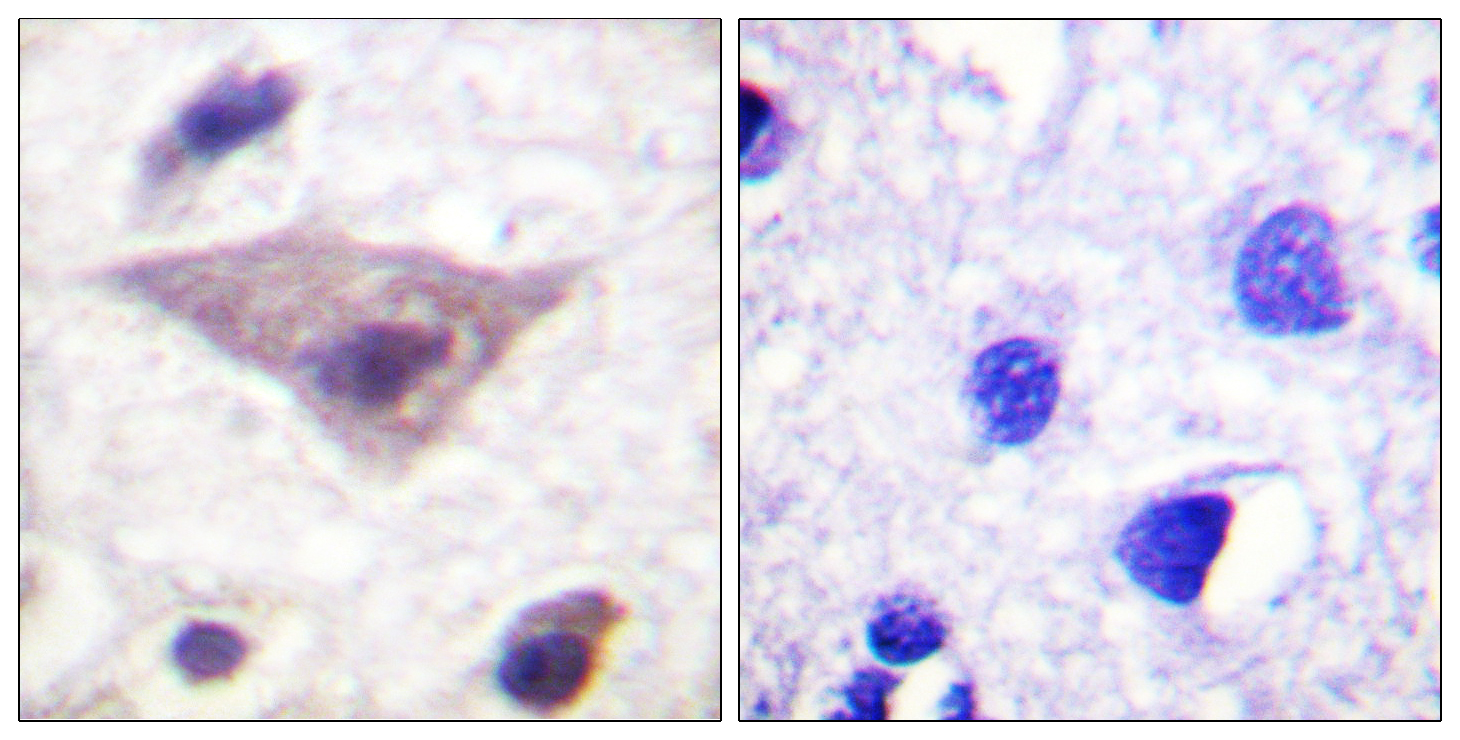
Catalog: YP0258
Size
Price
Status
Qty.
200μL
$600.00
In stock
0
100μL
$340.00
In stock
0
50μL
$190.00
In stock
0
Add to cart


Collected


Collect
Main Information
Target
Synuclein-α
Host Species
Rabbit
Reactivity
Human, Mouse, Rat
Applications
WB, IHC, IF, ELISA
MW
15kD (Observed)
Conjugate/Modification
Phospho
Detailed Information
Recommended Dilution Ratio
WB 1:500-1:2000; IHC 1:100-1:300; ELISA 1:5000; IF 1:50-200
Formulation
Liquid in PBS containing 50% glycerol, 0.5% BSA and 0.02% sodium azide.
Specificity
Phospho-Synuclein-α (S129) Polyclonal Antibody detects endogenous levels of Synuclein-α protein only when phosphorylated at S129.The name of modified sites may be influenced by many factors, such as species (the modified site was not originally found in human samples) and the change of protein sequence (the previous protein sequence is incomplete, and the protein sequence may be prolonged with the development of protein sequencing technology). When naming, we will use the "numbers" in historical reference to keep the sites consistent with the reports. The antibody binds to the following modification sequence (lowercase letters are modification sites):MPsEE
Purification
The antibody was affinity-purified from rabbit antiserum by affinity-chromatography using epitope-specific immunogen.
Storage
-15°C to -25°C/1 year(Do not lower than -25°C)
Concentration
1 mg/ml
MW(Observed)
15kD
Modification
Phospho
Clonality
Polyclonal
Isotype
IgG
Related Products
Antigen&Target Information
Immunogen:
The antiserum was produced against synthesized peptide derived from human Synuclein around the phosphorylation site of Ser129. AA range:91-140
show all
Specificity:
Phospho-Synuclein-α (S129) Polyclonal Antibody detects endogenous levels of Synuclein-α protein only when phosphorylated at S129.The name of modified sites may be influenced by many factors, such as species (the modified site was not originally found in human samples) and the change of protein sequence (the previous protein sequence is incomplete, and the protein sequence may be prolonged with the development of protein sequencing technology). When naming, we will use the "numbers" in historical reference to keep the sites consistent with the reports. The antibody binds to the following modification sequence (lowercase letters are modification sites):MPsEE
show all
Gene Name:
SNCA
show all
Protein Name:
Alpha-synuclein
show all
Other Name:
SNCA ;
NACP ;
PARK1 ;
Alpha-synuclein ;
Non-A beta component of AD amyloid ;
Non-A4 component of amyloid precursor ;
NACP
NACP ;
PARK1 ;
Alpha-synuclein ;
Non-A beta component of AD amyloid ;
Non-A4 component of amyloid precursor ;
NACP
show all
Database Link:
Background:
Alpha-synuclein is a member of the synuclein family, which also includes beta- and gamma-synuclein. Synucleins are abundantly expressed in the brain and alpha- and beta-synuclein inhibit phospholipase D2 selectively. SNCA may serve to integrate presynaptic signaling and membrane trafficking. Defects in SNCA have been implicated in the pathogenesis of Parkinson disease. SNCA peptides are a major component of amyloid plaques in the brains of patients with Alzheimer's disease. Alternatively spliced transcripts encoding different isoforms have been identified for this gene. [provided by RefSeq, Feb 2016],
show all
Function:
Alternative products:Additional isoforms seem to exist,Disease:Brain iron accumulation type 1 (NBIA1, also called Hallervorden-Spatz syndrome), a rare neuroaxonal dystrophy, is histologically characterized by axonal spheroids, iron deposition, Lewy body (LB)-like intraneuronal inclusions, glial inclusions and neurofibrillary tangles. SNCA is found in LB-like inclusions, glial inclusions and spheroids.,Disease:Defects in SNCA are a cause of autosomal dominant Parkinson disease 1 (PARK1) [MIM:168601, 168600]. Parkinson disease (PD) is a complex, multifactorial disorder that typically manifests after the age of 50 years, although early-onset cases (before 50 years) are known. PD generally arises as a sporadic condition but is occasionally inherited as a simple mendelian trait. Although sporadic and familial PD are very similar, inherited forms of the disease usually begin at earlier ages and are associated with atypical clinical features. PD is characterized by bradykinesia, resting tremor, muscular rigidity and postural instability, as well as by a clinically significant response to treatment with levodopa. The pathology involves the loss of dopaminergic neurons in the substantia nigra and the presence of Lewy bodies (intraneuronal accumulations of aggregated proteins), in surviving neurons in various areas of the brain.,Disease:Defects in SNCA are the cause of Lewy body dementia (DLB) [MIM:127750]. DLB is a neurodegenerative disorder clinically characterized by dementia and parkinsonism, often with fluctuating cognitive function, visual hallucinations, falls, syncopal episodes, and sensitivity to neuroleptic medication. Presence of Lewy bodies are the only essential pathologic features.,Disease:Defects in SNCA are the cause of Parkinson disease 4 (PARK4) [MIM:605543, 168600].,Disease:Deposition of fibrillar amyloid proteins intraneuronally as neurofibrillary tangles is characteristic of Alzheimer disease (AD). SNCA is a minor protein found within these deposits, but a major non amyloid component.,Domain:The NAC domain is involved in the fibril formation. The middle region forms the core of the filaments. The C-terminus may regulate aggregation and determine the diameter of the filaments.,Function:May be involved in the regulation of dopamine release and transport. Soluble protein, normally localized primarily at the presynaptic region of axons, which can form filamentous aggregates that are the major non amyloid component of intracellular inclusions in several neurodegenerative diseases (synucleinopathies). Induces fibrillization of microtubule-associated protein tau. Reduces neuronal responsiveness to various apoptotic stimuli, leading to a decreased caspase-3 activation.,PTM:Hallmark lesions of neurodegenerative synucleinopathies contain alpha-synuclein that is modified by nitration of tyrosine residues and possibly by dityrosine cross-linking to generated stable oligomers.,PTM:Phosphorylated, predominantly on serine residues. Phosphorylation by CK1 appears to occur on residues distinct from the residue phosphorylated by other kinases. Phosphorylation of Ser-129 is selective and extensive in synucleinopathy lesions. In vitro, phosphorylation at Ser-129 promoted insoluble fibril formation. Phosphorylated on Tyr-125 by a PTK2B-dependent pathway upon osmotic stress.,PTM:Ubiquitinated. The predominant conjugate is the diubiquitinated form.,similarity:Belongs to the synuclein family.,subcellular location:Membrane-bound in dopaminergic neurons. Also found in the nucleus.,subunit:Soluble monomer which can form filamentous aggregates. Interacts with UCHL1 (By similarity). Interacts with phospholipase D and histones.,tissue specificity:Expressed principally in brain but is also expressed in low concentrations in all tissues examined except in liver. Concentrated in presynaptic nerve terminals.,
show all
Cellular Localization:
Cytoplasm . Membrane . Nucleus . Cell junction, synapse . Secreted . Cell projection, axon . Membrane-bound in dopaminergic neurons (PubMed:15282274). Expressed and colocalized with SEPTIN4 in dopaminergic axon terminals, especially at the varicosities (By similarity). .
show all
Tissue Expression:
Highly expressed in presynaptic terminals in the central nervous system. Expressed principally in brain.
show all
Research Areas:
>>Alzheimer disease ;
>>Parkinson disease ;
>>Pathways of neurodegeneration - multiple diseases
>>Parkinson disease ;
>>Pathways of neurodegeneration - multiple diseases
show all
Signaling Pathway
Reference Citation({{totalcount}})
Catalog: YP0258
Size
Price
Status
Qty.
200μL
$600.00
In stock
0
100μL
$340.00
In stock
0
50μL
$190.00
In stock
0
Add to cart


Collected


Collect
Recently Viewed Products
Clear allPRODUCTS
CUSTOMIZED
ABOUT US
Toggle night Mode
{{pinfoXq.title || ''}}
Catalog: {{pinfoXq.catalog || ''}}
Filter:
All
{{item.name}}
{{pinfo.title}}
-{{pinfo.catalog}}
Main Information
Target
{{pinfo.target}}
Reactivity
{{pinfo.react}}
Applications
{{pinfo.applicat}}
Conjugate/Modification
{{pinfo.coupling}}/{{pinfo.modific}}
MW (kDa)
{{pinfo.mwcalc}}
Host Species
{{pinfo.hostspec}}
Isotype
{{pinfo.isotype}}
Product {{index}}/{{pcount}}
Prev
Next
{{pvTitle}}
Scroll wheel zooms the picture
{{pvDescr}}




















